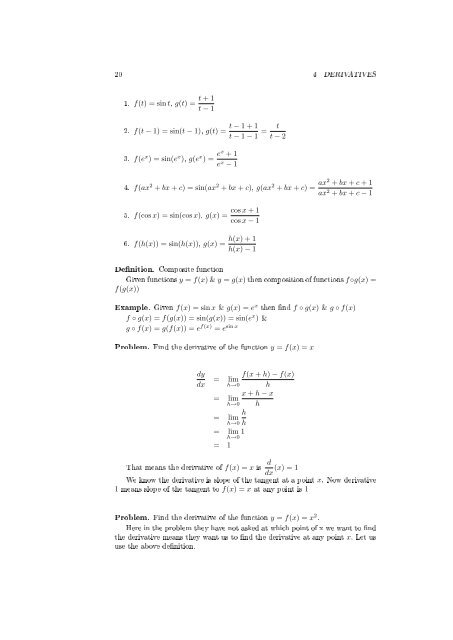Denition approach of learning new topics
Create successful ePaper yourself
Turn your PDF publications into a flip-book with our unique Google optimized e-Paper software.
20 4 DERIVATIVES<br />
1. f(t) = sin t, g(t) = t + 1<br />
t − 1<br />
2. f(t − 1) = sin(t − 1), g(t) = t − 1 + 1<br />
t − 1 − 1 = t<br />
t − 2<br />
3. f(e x ) = sin(e x ), g(e x ) = ex + 1<br />
e x − 1<br />
4. f(ax 2 + bx + c) = sin(ax 2 + bx + c), g(ax 2 + bx + c) = ax2 + bx + c + 1<br />
ax 2 + bx + c − 1<br />
5. f(cos x) = sin(cos x), g(x) = cos x + 1<br />
cos x − 1<br />
6. f(h(x)) = sin(h(x)), g(x) = h(x) + 1<br />
h(x) − 1<br />
<strong>Denition</strong>. Composite function<br />
Given functions y = f(x) & y = g(x) then composition <strong>of</strong> functions f ◦g(x) =<br />
f(g(x))<br />
Example. Given f(x) = sin x & g(x) = e x then nd f ◦ g(x) & g ◦ f(x)<br />
f ◦ g(x) = f(g(x)) = sin(g(x)) = sin(e x ) &<br />
g ◦ f(x) = g(f(x)) = e f(x) = e sin x<br />
Problem. Find the derivative <strong>of</strong> the function y = f(x) = x<br />
dy<br />
dx = lim f(x + h) − f(x)<br />
h→0 h<br />
x + h − x<br />
= lim<br />
h→0 h<br />
= lim<br />
h<br />
= lim 1<br />
h→0<br />
= 1<br />
h→0<br />
h<br />
That means the derivative <strong>of</strong> f(x) = x is d<br />
dx (x) = 1<br />
We know the derivative is slope <strong>of</strong> the tangent at a point x. Now derivative<br />
1 means slope <strong>of</strong> the tangent to f(x) = x at any point is 1<br />
Problem. Find the derivative <strong>of</strong> the function y = f(x) = x 2 .<br />
Here in the problem they have not asked at which point <strong>of</strong> x we want to nd<br />
the derivative means they want us to nd the derivative at any point x. Let us<br />
use the above denition.



